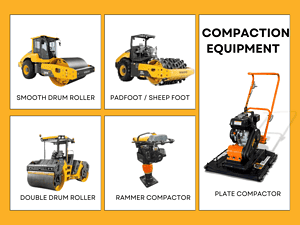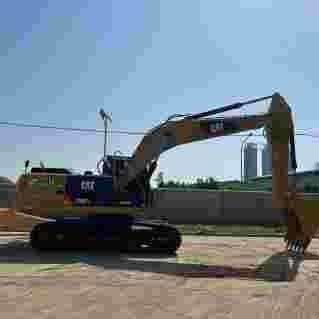The safety of your employees is the most important concern, so make the right decision based on your business’s specific needs and capabilities. Use your own discretion and make the best decision for your situation. Consider the brand’s reputation, the size of the equipment, and the maintenance. As the business owner, you are the best judge of what you can and cannot afford.
To choose the right lifting equipment list for your construction business, focus on evaluating the brand, considering equipment size and capacity, and factoring in long-term maintenance. Researching top manufacturers like Kubota, CAT, and Komatsu can help you find reliable options. Make sure to assess equipment longevity, service availability, and operating costs to ensure maximum return on investment.
Now that you know what to look for, let’s get into the details on how to choose the right lifting equipment for your business.

Table des matières
BasculerUnderstanding the Types of Lifting Equipment
Common Types of Lifting Equipment in Construction
When planning your lifting equipment list, you need to understand the different types of equipment available and what you need to do the job. Most equipment is designed for a specific task, so knowing what equipment does what can save you a lot of time and money. Here are the most common types:
| Lifting Equipment | Description | Best For |
| Cranes | Large machines that lift heavy loads vertically, often with the help of a jib or boom. | Heavy-duty lifting tasks like hoisting beams, steel, and large machinery. |
| Forklifts | Machines used for lifting and moving materials over short distances, often with forks or pallets. | Material handling and storage in warehouse spaces or at ground level. |
| Hoists | Mechanical devices that lift heavy objects vertically by using pulleys or chains. | Vertical lifting of smaller loads in confined spaces or buildings. |
| Lifts | Platform-based machines that elevate workers or materials to high areas. | Access to high places for workers or material handling in construction and maintenance. |
Cranes
Cranes are one of the most versatile pieces of lifting equipment. They are for picking up something heavy and taking it a long way. They are great for setting structural steel on buildings, taking equipment to the top of a skyscraper, or setting beams on a bridge. There are many types of cranes, including: Tower cranes Mobile cranes Overhead cranes An expert can help you choose the best type for your project.
| Type of Crane | Best For | Pros | Cons |
| Tower Cranes | Large-scale construction like skyscrapers and bridges. | High lifting capacity, extended reach | Requires a lot of space and setup time |
| Mobile Cranes | Construction sites with mobility needs. | Easy to relocate, versatile | Limited reach compared to tower cranes |
| Overhead Cranes | Factory and warehouse environments. | Ideal for lifting large loads in factories | Expensive, limited to one location |
Forklifts
Forklifts are critical in construction. They are used to move stuff like bricks, material, tools, and small equipment short distances quickly. They are useful for putting stuff in storage and for when you need to be organized. There are two primary types of forklifts: regular forklifts and rough terrain forklifts. The rough terrain forklift is essential when you have to move materials outside on uneven ground.
Hoists
A hoist is small lifting machine designed to pick up something light. It is ideal for use in a small area, a smaller construction site, or when you are working in a tight space and you can’t use a crane. This might include when the crane can’t reach a location because the building is in the way. You use hoists to build the building, install the elevators, maintain the lighting, or any other electrical work needed on the job.
Lifts
Lifts are needed to access the following: Aerial lift: Used for painting, working on electrical lines, or anything that requires someone to be high above the ground. Scissor lift: This lift has a platform the worker can stand on. They raise and lower the platform using a scissor-type mechanism underneath. These are more stable in a straight up-vertical lift than the other types of lifts.
Normally, workers use scissor lifts to install lighting and for other tasks. Boom lift: A boom lift has a platform for the worker to stand on, but it also has an articulated arm that allows the platform to be maneuvered into tight places. The operator raises the platform with a hydraulic lift system and uses a joystick to move the arm where it needs to go.
Identifying Your Specific Project Needs
Understanding what you do on your job helps determine what lifting equipment to use. Questions to consider should include: What is the weight of the object I am trying to pick up? How high do I need to pick it up? How much room do I have to work? Do I need to pick the object up in one spot and set it down in another? Here are some examples of lifting equipment and the task where you might use them on a construction project.
Key Factors to Consider:
| Type de projet | Recommended Equipment | Key Considerations |
| Heavy Lifting Projects | Cranes (e.g., Tower Cranes) | Large load capacity, extended reach, robust lifting power |
| Material Handling | Forklifts, Hoists | Mobility, load weight, ease of use |
| Work at Heights | Lifts, Aerial Work Platforms | Stability, reach, safety features |
| Tight Space Projects | Hoists, Mini Cranes | Compact design, vertical lifting |
Heavy Lifting Projects
For example, a steel building project will involve lifting heavy objects, such as steel beams or large equipment. In that case, a crane is required for lifting these materials. As with forklifts, there are various types of cranes and the best one to use will depend on your situation. In a steel building project, you may need a tower crane if you are setting materials 50 stories high. A tower crane will do that and more, but it requires lots of assembly and a big space to sit. For a lot of movement, such as setting a steel building with multiple crane pick points, a mobile crane could be the type of crane you would use.
Material Handling
For steel building projects, though, you will usually need to lift a lot of weight at heights over your head in a large area. In that situation, you will likely need a crane.
Work at Heights
For larger projects, such as those where you have a lot of steel to lift and you’re lifting it high off the ground over a big area, you’ll probably need a crane. Overall, if the project requires personnel to be off the ground at height, the most reliable machine to use is a lift. An aerial work platform or a scissor lift are both great solutions because they’re working sills and they have mobility.
Tight Space Projects
When the project is large, where you have a bunch of steel to lift and you’re lifting it high in the air over a large area, then you’re probably going to need a crane. For the most part, if you’re just picking up personnel and getting them off the ground at height, the most reliable machine is a lift. Both an aerial work platform and a scissor lift are great solutions because you’re working still and they have mobility.

Budgeting for Lifting Equipment
When deciding to purchase or rent a piece of lifting equipment, financial considerations are crucial. Because heavy equipment is expensive, it can be tempting to rent it instead. Both choices have their benefits and potential concerns. Which is best for a business or individual? It all depends on the frequency and the size of the project.
Purchasing vs. Renting Lifting Equipment
| Option | Pros | Cons |
| Purchasing | Long-term investment, full control over equipment | High initial cost, maintenance responsibility |
| Renting | Lower upfront cost, access to newer equipment | Ongoing rental fees, limited customization options |
Purchasing Lifting Equipment
When you buy lifting equipment, it’s a long-term investment in your business. While there’s an upfront cost of purchase that’s typically pretty high, now you have the equipment available on your site whenever you want to use it. But, you also have the responsibility of maintaining it, and there are repair costs if the machine breaks down.
| Considerations | Avantages | Challenges |
| Upfront Cost | High initial investment for long-term use. | Strains cash flow in the short term. |
| Ownership | Full control over equipment and its usage. | Ongoing maintenance and repairs required. |
Renting Lifting Equipment
Renting is a good option for getting machinery when a business has a short-term project and doesn’t want to spend the money upfront to buy it. Another benefit of renting equipment is the business can rent better
equipment than it could afford to buy. When you rent lifting equipment, the rental company is responsible for maintenance and most repairs.
| Considerations | Avantages | Challenges |
| Lower Initial Cost | Renting requires little to no upfront cost. | Rental costs accumulate over time. |
| No Maintenance | Equipment is maintained by the rental company. | Limited customization and availability during peak seasons. |
Ensuring Safety and Compliance
In construction, all lifting equipment must meet certain safety standards because workers’ lives depend on it. Nobody wants to have an accident where somebody is injured or killed, and nobody wants to have a part of
the building drop off. Make sure at a minimum the lifting equipment meets the safety standards of OSHA, any other organization in the chain requiring compliance, and the manufacturer requirements for maintenance
and operational use.
Key Safety Considerations:
| Safety Feature | Importance | Required Compliance |
| Weight Capacity | Prevents overloading and accidents | OSHA guidelines, manufacturer specifications |
| Operator Training | Reduces accidents and ensures proper handling | Certification programs for lifting equipment operators |
| Routine Inspections | Ensures equipment is safe and reliable | Regular checks per safety regulations |
Weight Capacity
Check to see the weight capacity of whatever lifting equipment you or your workers operate. Overloading the equipment can cause a catastrophic failure during the lift. Serious injury or potential death could occur if this happens. Therefore, always verify the capacity of the lifter meets or exceeds the weight of the object they’re lifting, or it could turn into a dangerous situation.
Operator Training
Use certified operators. And, by certified, I mean they actually know what they’re doing. They have been certified or have a lot of experience operating the lifting equipment you’re using. This is important to prevent people from being injured or killed because somebody did not know what they were doing.
Routine Inspections
Lifting equipment requires regular inspection. For example, OSHA requires companies to inspect lifting equipment periodically in most situations. Check with the safety regulations in your location to determine
how often you need to inspect your equipment and then make sure you have a qualified operator verify that safety compliance.

Choosing Between New vs. Used Lifting Equipment
One significant decision when it comes to lifting equipment is whether you decide to buy it new or used. Let me cover buying first. If you decide to buy the equipment, you’re making a big financial decision. Generally, it’s
an expensive purchase, but you will always have lifting equipment available when you need it. On the other hand, the decision also comes with the obligation to maintain the equipment on a regular basis, or you could wind up with a huge repair bill on your hands.
Pros and Cons of New vs. Used Equipment
| Equipment Type | Pros | Cons |
| New Equipment | Latest features, warranty, low maintenance | Higher initial cost, depreciation |
| Used Equipment | Lower cost, still functional if inspected | Potential wear and tear, lack of warranty |
New Lifting Equipment
New equipment comes with all the latest safety features and technology to help you lift more efficiently and safer, making your business more money. Unfortunately, the initial price is more expensive, and that equipment starts to depreciate as soon as you sign the paperwork to buy it, just like a new car. Also, be prepared to spend time, money, and resources maintaining that equipment throughout its entire useful life.
Used Lifting Equipment
To combat sticker shock, consider buying used equipment. This is usually the cheapest way to get this kind of gear, especially for a small company or one-time project. Just make sure the gear is clean and in good condition, and check with the seller about any outstanding operational problems or repairs needed.
Maintenance Best Practices for Lifting Equipment
| Maintenance Task | Frequency | Importance |
| Routine Inspections | Monthly or per project | Prevents breakdowns and ensures safety |
| Lubrication of Moving Parts | Bi-monthly | Reduces friction and wear on components |
| Check for Wear and Tear | After every major job | Ensures equipment reliability |
Routine Inspections
Inspect the crap out of your equipment. Every time you mount it, hook it up, rent it, share it, or use it, look for damage, leaks, or poor performance. If you see something, say something. Periodic and routine inspections are necessary and pay off big time. Spend time to go over your equipment. Check everything! Don’t just give it a quick walk-around. Get into the hydraulic system, electrical items, and everything else that carries the load or makes the thing work. These inspections can catch small problems before they turn into big problems.
Lubrication of Moving Parts
Keep it lubed. The key to any mechanical piece of equipment is to keep the things that rub against each other lubed up. Hydraulic cylinders, swivels, pins and bushings, and any moving parts that help open or close, up or down, in or out—these all require regular lubrication. Lubrication keeps the metal from rubbing against metal, preventing wear and premature failure of the piece intended to move the earth. Regular lubrication requires that you follow the recommendations of the manufacturer provided in the manual.
Check for Wear and Tear
After every major task, check your lifting equipment for wear and damage. Pay attention to the tires, cables, and hydraulic hoses. If they are showing signs of damage, stress, or wear, it’s time to replace those components before you use the equipment on the next job. Paying close attention to these items can save a life and your wallet.
After the job is complete, check the equipment for wear and tear. Check the tires and cables. Inspect the hydraulic hoses, and so forth. Make sure all parts are in good working order so the equipment is ready to go for the next job. Today, if a part of your equipment is showing a lot of stress, change it before you consider using it again. You need to change parts before they break to take good care of your equipment and the people who work on it.
Conclusion
Buying the right brand and then taking care of it are the keys to successful, profitable construction projects. Brands like Kubota, CHAT, and Komatsu have been doing it for a while. They’ll offer a reliable solution for your construction business, whether you’re working in your backyard or building multi-million-dollar projects. But no matter the name on the machine, it’s how you take care of it that ensures its longevity. It all comes down to performing a proper inspection, lubrication, and taking care of the worn-out little things on a regular basis. By purchasing the most reliable brand and taking care of it, you’ll minimize unexpected downtime, save yourself tons of money, and continue to get the job done.
Suivez-nous sur:Youtube.










